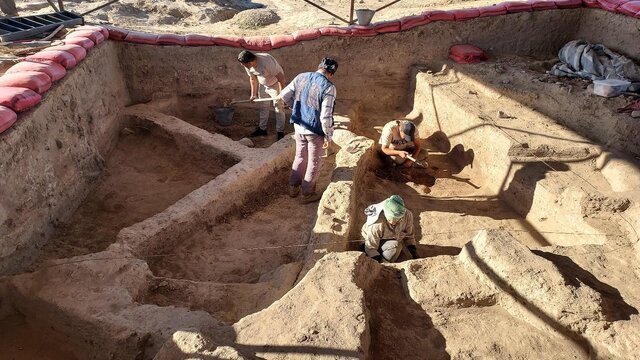Archaeological excavations begin at Iran's ‘largest’ Neolithic site

TEHRAN - The third season of archaeological excavations has officially begun at Chogha Golan, a significant Neolithic site in the foothills of the Zagros Mountains, near Mehran in Ilam province.
The project is being carried out on Iran’s largest Neolithic site iwith authorization from the Research Institute of Cultural Heritage and Tourism, ISNA reported.
According to Hojjat Darabi, head of the Chogha Golan archaeological team, this season's excavation involves both vertical and horizontal trenching across two areas. The objective is to uncover evidence dating back to the 9th and 8th millennia BC to better understand the origins of agriculture and sedentary life in the region.
“So far, we've uncovered architectural remains made of mudbrick and clay, a substantial number of lithic tools and artifacts, as well as clay figurines and objects,” Darabi stated. “In one architectural space, we discovered six successive plaster floors, indicating multi-generational use of the area by Chogha Golan's early inhabitants.”
Darabi also highlighted the discovery of a wide range of animal and plant remains from various layers at the site. These findings are expected to provide fresh insights into the domestication of animals and plants in the Zagros region and the broader area of Western Asia, the archaeologist added.

Chogha Golan, previously studied by a German archaeological team, is notable for its continuous human occupation from the early 10th to the mid-8th millennium BC. “Covering an area of approximately 5.5 hectares, it is considered the largest Neolithic archaeological site discovered in Iran to date,” the archaeologist stated.
"The site’s size and extended occupational sequence make continued excavations at Chogha Golan essential," Darabi emphasized. "It not only deepens our understanding of early human settlements in Iran but also enhances the country’s position in global prehistoric research."
The excavation efforts are expected to contribute significantly to the field of Near Eastern archaeology and the study of early agricultural societies.
According to sources, Chogha Golan is particularly notable for the early domestication of emmer wheat, dating to around 9,800 BP. The archaeobotanical remains from Chogha Golan provide the earliest evidence of long-term plant management in Iran.
Situated in a semi-arid region about 30 kilometers north of Mehran, it is one of the earliest aceramic Neolithic sites discovered in Iran. The inhabitants of Chogha Golan primarily relied on hunting and the utilization of wild plants.
Chogha Golan was excavated jointly by archaeologists from the University of Tübingen and the Iranian Center for Archaeological Research in 2009 and 2010. The site is characterized by a hill rising approximately 7 to 8 meters high and contains 8 meters of cultural deposits.
AM
Leave a Comment